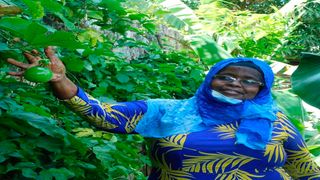
Anisa Abdalla on her farm in Kikambala, Kilifi County.
| Bozo Jenje | Nation Media GroupSeeds of Gold
Premium
From subsistence to commercial farming: Making the transition
What you need to know:
- Apart from growing crops, she also keeps 23 Kienjeji birds that she sells at Sh1,000 each, goose, turkeys, rabbits and 16 Galla goats.
Anisa Abdalla wears many hats, which she juggles with ease.
She is the chairperson of the Agricultural Society of Kenya (ASK), Mombasa branch, and Athletics Kenya in the county.
She is also a board member of Women Indian Chamber of Commerce and Industry, the proprietor of Anfrid, an event organising firm and lastly, she is a farmer.
On her half-acre farm near the North Coast Medical College in Kikambala, Kilifi County, she grows various crops that include amaranth, collard greens, onions and fruits.
Amaranth is her major crop, thanks to its high demand at the Coast, where it is known as mchicha.
“My interest in farming started in mid 1980s as I served in various committees at the Agricultural Society of Kenya. Then, I was growing crops small-scale for home consumption,” says the 58-year-old.
“Then in 2015, I thought about planning for my retirement and saw farming was the best venture to engage in.”
Dream comes true
But it was not until 2018 that she actualised her dream, having drilled a borehole some years back.
This followed a visit to Kenya Seeds Company, Syngenta and Amiran stands at the Mombasa ASK show where she was advised the crops to grow, among them amaranth, okra, tomato and brinjal.
She went for the horticultural crops, going big on amaranth.
To grow amaranth, she starts with propagating the seeds in a nursery bed.
“Once done, I broadcash the seeds in the nursery and mix with soil, then water twice a day until they germinate after a week. The watering continues after the seeds are transferred from the nursery to the farm,” she says, adding she uses animal manure to grow the crops.
Three weeks after planting, harvesting commences.
“I got my firrt harvest from amaranth, okra and brinjal and was so happy. I harvest at least100 kilos of each and sold it to my neighbours in Tudor at between Sh40 and Sh60 each,” says Anisa, who employs one worker. This has encouraged her to grow more plants and keep several animals as she slowly commercialises her farm.
It also hosts two soursop trees, 10 pawpaws, 14 assorted banana plants, passion plants, quarter-acre cassava and various vegetables, which she grows under irrigation, with the system having cost her Sh42,000 during installation.
Birds
Apart from growing crops, she also keeps 23 Kienjeji birds that she sells at Sh1,000 each, goose, turkeys, rabbits and 16 Galla goats.
“I keeping all these as a journey to commercialise my farm. I am also increasing the production of amaranth and other crops,” she says.
She is working on buying four acres near her farm and utilise the 7.5 acres of family land in Ramisi. “This will increase production of crops like cassava and bananas. I will also have more space to grow fodder for the animals,” says Anisa.
Her challenges include pests that affect the quality of her crops, with alligators also eating her chickens.
“The good thing with farming is that there is continuous learning especially when it comes to management of both crops and livestock. Sometimes things fail but you have to move on.”
Her plan is to increase the number of turkeys, chickens and Galla goats, which she will breed for sale.
Anisa’s work at ASK has seen her rub shoulders with Former presidents Daniel Moi, Mwai Kibaki, Uhuru Kenyatta, Ali Hassan Mwinyi and Robert Mugabe.
Taita Taveta University senior business lecturer, Dr Karim Hassanali Omido, says farming as a business should be driven by profits. “Farmers need market information and to understand the seasons to enable them to be competitive and earn profits,'' Dr Omido says.
He notes that the transition from subsistence to commercial farming enables a farmer earn more as tehy increase production.
“A farmer will also do better and commit less mistakes as they have learnt what to do while farming for subsistence.”





